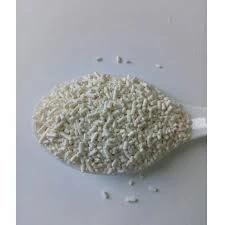
e435 emulsifier
Understanding E435 The Multifunctional Emulsifier
Emulsifiers play a crucial role in the food and cosmetic industries, acting as agents that help blend two immiscible liquids like oil and water. One such emulsifier that has gained prominence is E435, also known as polysorbate 60. Derived from the esterification of sorbitol and fatty acids, E435 boasts a range of applications, making it a versatile component in many products we encounter daily.
What is E435?
E435 is a non-ionic surfactant, categorized under the polysorbates — a series of emulsifying agents that are derived from sorbitol and different fatty acids. It serves primarily to stabilize emulsions, enabling oil and water to mix effectively. The 'E' in E435 denotes its approval as a food additive in the European Union, where food and cosmetic products are labeled with their E-numbers for identification.
E435 is particularly valued for its ability to lower surface tension, which facilitates the emulsification process. This property is vital in various applications, as it helps create uniform textures and increases the stability of emulsions over time.
Uses of E435
1. Food Industry E435 is widely used in the food sector as an emulsifier, stabilizer, and thickening agent. It is commonly found in products like ice cream, salad dressings, and sauces, where it helps to achieve a smooth, creamy texture. Its ability to keep ingredients uniformly dispersed prevents separation and enhances the mouthfeel of food items.
e435 emulsifier

2. Baked Goods In baked products, E435 helps improve the texture and shelf-life. It can help retain moisture, thereby improving the freshness of cakes and pastries. By ensuring an even distribution of fats throughout the dough, it also contributes to a better rise and crumb structure.
3. Cosmetics and Personal Care Beyond food, E435 is prevalent in cosmetics and personal care products, including lotions, creams, and shampoos. Its emulsifying properties allow for the blending of oil-based and water-based ingredients, providing a smooth consistency essential for skincare formulations. E435 also acts as a stabilizing agent, preventing separation and maintaining the integrity of the product over time.
4. Pharmaceuticals In the pharmaceutical industry, E435 is used in various applications including topical ointments and oral medications. It aids in the formulation of products by enhancing the dispersion of active ingredients and improving their absorption in the body.
Safety and Regulatory Status
E435 has been evaluated by several health and safety authorities, including the European Food Safety Authority (EFSA) and the U.S. Food and Drug Administration (FDA). It is generally recognized as safe (GRAS) for use in foods and cosmetics within specified limits. However, as with any additive, it is essential to consume products containing E435 within recommended guidelines. Some individuals may have sensitivities or allergies to polysorbates, although such reactions are relatively rare.
Conclusion
E435 (polysorbate 60) is a multifunctional emulsifier that significantly contributes to the texture, stability, and quality of numerous food and cosmetic products. Its ability to blend oil and water efficiently allows for smoother, creamier products that consumers enjoy. As the demand for processed foods and cosmetics continues to rise, the reliance on emulsifiers like E435 will remain paramount. Nevertheless, it is crucial for consumers to be aware of ingredient labels and make informed choices regarding their food and personal care products. Overall, E435 exemplifies the importance of emulsifiers in modern formulations, enhancing both the culinary and personal care experiences.
-
Aluminum Hydroxide: Quality Gels & Dried Gel AntacidNewsAug.31,2025
-
Buy High-Quality Trichloroisocyanuric Acid for Sale | TCCA 90% SupplierNewsAug.30,2025
-
Pure Sodium Dichloroisocyanurate Dihydrate | Powerful DisinfectantNewsAug.29,2025
-
Industrial Chemicals: Quality & Purity for Every IndustryNewsAug.28,2025
-
Nitrile Rubber Honoring Strict Production StandardsNewsAug.22,2025
-
Aspartame Ingredients Honoring Food Safety ValuesNewsAug.22,2025
-
Fertilizer for Balanced Plant NutritionNewsAug.22,2025
Hebei Tenger Chemical Technology Co., Ltd. focuses on the chemical industry and is committed to the export service of chemical raw materials.
-

view more DiethanolisopropanolamineIn the ever-growing field of chemical solutions, diethanolisopropanolamine (DEIPA) stands out as a versatile and important compound. Due to its unique chemical structure and properties, DEIPA is of interest to various industries including construction, personal care, and agriculture. -

view more TriisopropanolamineTriisopropanolamine (TIPA) alkanol amine substance, is a kind of alcohol amine compound with amino and alcohol hydroxyl, and because of its molecules contains both amino and hydroxyl. -

view more Tetramethyl Thiuram DisulfideTetramethyl thiuram disulfide, also known as TMTD, is a white to light-yellow powder with a distinct sulfur-like odor. It is soluble in organic solvents such as benzene, acetone, and ethyl acetate, making it highly versatile for use in different formulations. TMTD is known for its excellent vulcanization acceleration properties, which makes it a key ingredient in the production of rubber products. Additionally, it acts as an effective fungicide and bactericide, making it valuable in agricultural applications. Its high purity and stability ensure consistent performance, making it a preferred choice for manufacturers across various industries.





